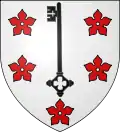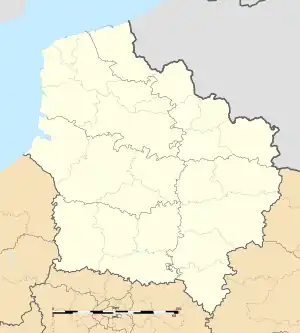Comines | |
|---|---|
_JPG01.jpg.webp) Town hall and belfry | |
 Coat of arms | |
Location of Comines | |
 Comines  Comines | |
| Coordinates: 50°45′42″N 3°00′31″E / 50.7616°N 3.0086°E | |
| Country | France |
| Region | Hauts-de-France |
| Department | Nord |
| Arrondissement | Lille |
| Canton | Lambersart |
| Intercommunality | Métropole Européenne de Lille |
| Government | |
| • Mayor (2020–2026) | Éric Vanstaen[1] |
| Area 1 | 16.02 km2 (6.19 sq mi) |
| Population | 12,671 |
| • Density | 790/km2 (2,000/sq mi) |
| Time zone | UTC+01:00 (CET) |
| • Summer (DST) | UTC+02:00 (CEST) |
| INSEE/Postal code | 59152 /59560 |
| Elevation | 11–24 m (36–79 ft) (avg. 18 m or 59 ft) |
| 1 French Land Register data, which excludes lakes, ponds, glaciers > 1 km2 (0.386 sq mi or 247 acres) and river estuaries. | |
Comines (French pronunciation: [kɔmin]; Dutch: Komen) is a commune of the Nord department in northern France.[3]
Geography
The town of Comines sits on the Franco-Belgian border and is split into two parts: Comines (France) and Comines (Belgium), part of the municipality of Comines-Warneton.
Population
| Year | Pop. | ±% p.a. |
|---|---|---|
| 1968 | 10,128 | — |
| 1975 | 10,485 | +0.50% |
| 1982 | 10,915 | +0.58% |
| 1990 | 11,320 | +0.46% |
| 1999 | 11,952 | +0.61% |
| 2007 | 12,208 | +0.27% |
| 2012 | 12,787 | +0.93% |
| 2017 | 12,358 | −0.68% |
| Source: INSEE[4] | ||
Heraldry
 Arms of Comines |
The arms of Comines are blazoned : Argent, a key palewise sable between 5 cinqfoils gules 2,2,1.
|
Sights
The belfry of Comines was listed as a UNESCO World Heritage Site as part of the Belfries of Belgium and France in 2005, in recognition of its importance to the history of municipal power in Europe.[5]
See also
References
- ↑ "Répertoire national des élus: les maires" (in French). data.gouv.fr, Plateforme ouverte des données publiques françaises. 13 September 2022.
- ↑ "Populations légales 2021". The National Institute of Statistics and Economic Studies. 28 December 2023.
- ↑ INSEE commune file
- ↑ Population en historique depuis 1968, INSEE
- ↑ "Belfries of Belgium and France". UNESCO World Heritage Centre. United Nations Educational, Scientific, and Cultural Organization. Retrieved 5 November 2021.
Wikimedia Commons has media related to Comines, Nord.
This article is issued from Wikipedia. The text is licensed under Creative Commons - Attribution - Sharealike. Additional terms may apply for the media files.
